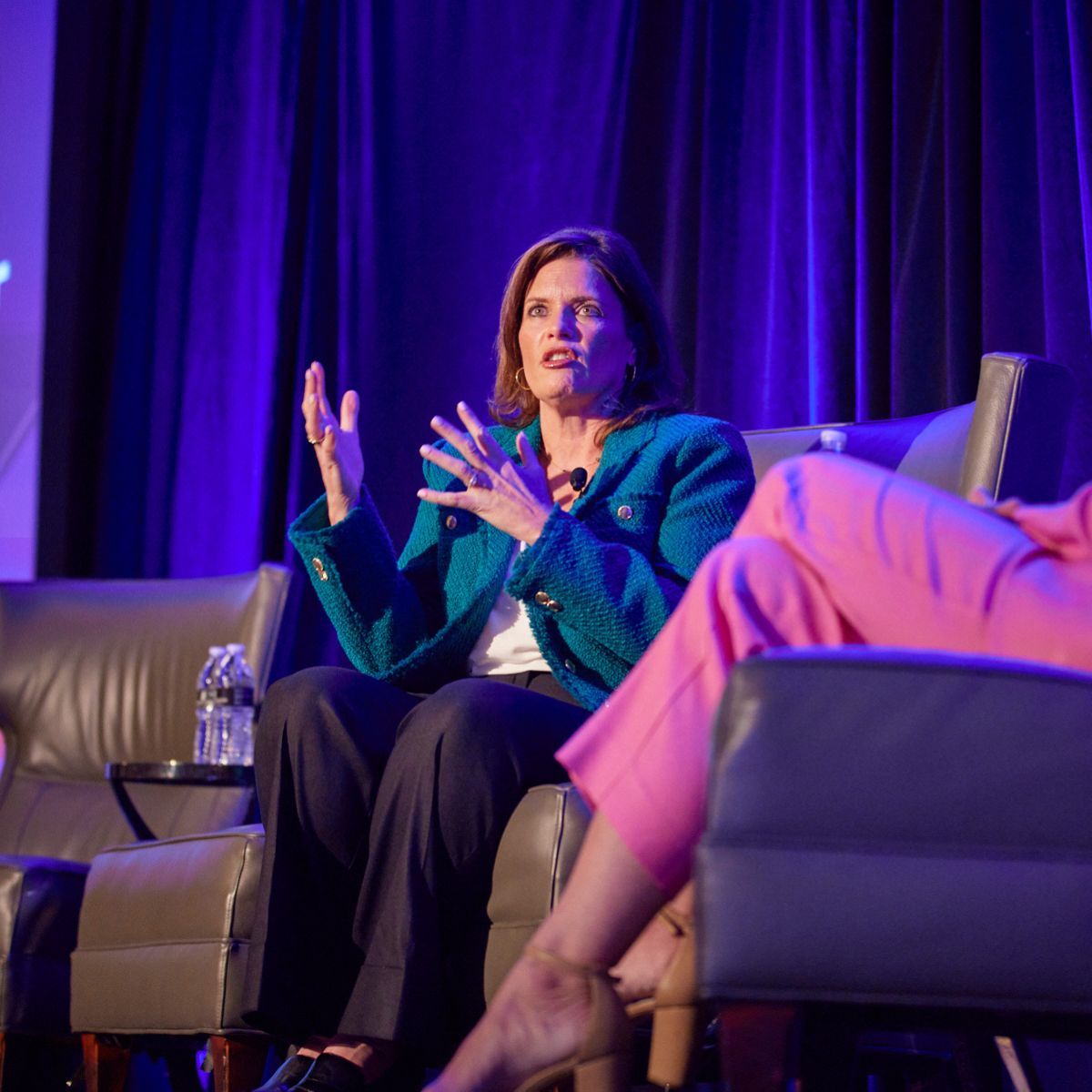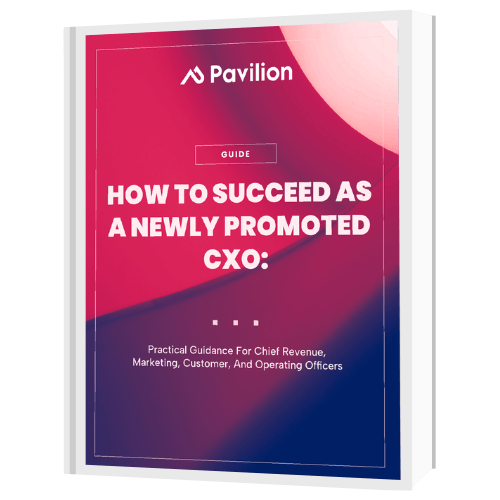
Making the Leap from VP to CXO:
Practical Guidance for first-time Chief Revenue, Marketing, Customer, and Operating Officers
TL;DR
Why This Guide Matters
The VP → CXO leap isn’t just a promotion—it’s a paradigm shift.
When you move from Vice President to the C-suite, the expectations shift dramatically—often without warning. You’re no longer managing a function. You’re shaping the direction of the entire business. You’re not just delivering outcomes. You’re now accountable for the why, how, and what’s next—to your team, your CEO, and often, your board.
Yet most GTM leaders aren’t handed a playbook when they’re promoted. Instead, they inherit unclear expectations, fragmented cross-functional dynamics, and new forms of scrutiny. One day you’re the high-performing VP everyone relies on. The next, you’re the CXO expected to unify revenue strategy, influence enterprise priorities, and build future-proof systems—all while proving you deserved the seat.
That’s why this guide exists.
Rooted in research from Pavilion’s global network of GTM leaders—and informed by frameworks used by top-performing executives—this is not just another “how to be a better leader” blog. It’s a high-signal, high-utility resource for navigating the first year in a CXO role with clarity, confidence, and impact.
You’ll find:
- Role-specific 90-day playbooks
- Peer benchmarks and success metrics
- Real-world frameworks to align teams, communicate with boards, and deliver results
- Guidance on how to grow from functional expert to enterprise leader
Who it’s for
Chief Revenue, Marketing, Customer, and Operating Officers (CRO, CMO, CCO, COO) recently promoted from VP-level roles in B2B tech companies—especially those leading go-to-market (GTM) teams at growth-stage organizations.
Whether you’re one week into your new title or six months into the deep end, this guide is designed to meet you where you are—and help you lead with leverage.

Table of contents
-
-
- The Real Difference Between VP and CXO
- The Four Core Shifts Every New CXO Must Make
- What the Board Now Expects From You
- 90-Day Playbook for Each CXO Role
- One-Year Roadmap: From Survival to Strategic Impact
- Peer Benchmarks and Success Metrics
- Common Pitfalls and How to Avoid Them
- Building Influence, Not Just Strategy
- Future-Proofing: Evolving as a Modern GTM Executive
- Resources: Templates, Checklists, Frameworks
-
From Team Leader to Org-Wide Leader
As a VP, you’re responsible for driving performance within a function—whether that’s sales, marketing, customer success, or operations. As a CXO, your focus shifts from functional execution to enterprise alignment. Your decisions now ripple across departments, influence company-wide strategy, and shape outcomes far beyond your direct team.
From Internal Visibility to Cross-Functional Accountability
In a VP role, success is often defined by how well you execute within your silo. But CXOs are held accountable for outcomes that require collaboration across silos. You’re expected to align sales with marketing, marketing with product, customer success with revenue operations—and ensure it all maps back to the company’s strategic goals.
From Influence to Ownership
VPs influence outcomes. CXOs own them. That includes owning a budget, managing investor or board-level expectations, and making decisions with incomplete information. You now carry the weight of cross-functional trade-offs, long-term bets, and structural decisions that will shape the business for years to come.
Key Differences at a Glance
| Responsibility Area | VP Level | CXO Level |
|---|---|---|
| Primary Focus |
Functional execution | Enterprise alignment |
| Scope of Decisions | Departmental | Cross-functional and company-wide |
| Visibility | Executive team and functional team | CEO, board, investors, cross-functional |
| Time Horizon | Quarterly targets | Long-term strategy and future-proofing |
| Budget Ownership | Department-level budgets | Multi-functional or company-level P&L |
| Success Metrics | Team performance, pipeline, campaigns | Revenue growth, retention, margin, valuation impact |
This shift requires more than ambition—it requires new frameworks, expanded fluency in cross-functional strategy, and the ability to lead through influence and insight at the highest levels.
In the following sections, we’ll break down how to navigate this transition with the clarity and confidence required to thrive in your first year as a CXO.

2. The Four Core Shifts Every New CXO Must Make
Stepping into a CXO role doesn’t just mean scaling what you did well as a VP—it means operating in fundamentally different ways. The tools, habits, and mindset that got you promoted are often insufficient—or even counterproductive—at the C-level. Here are the four essential shifts every new CXO must make to succeed.
From Executor to Architect
As a VP, you likely thrived by getting things done—running campaigns, closing deals, managing teams. But at the CXO level, your value is no longer measured by your ability to execute tactics. It’s measured by how effectively you design the systems others execute within. That means building scalable structures, processes, and rituals that outlast any one quarter—or person.
What this looks like:
- Designing incentive plans that align behaviors across functions
- Creating scalable onboarding programs instead of running 1:1 trainings
- Defining operating cadences that create leverage across your team
From Owning a Function to Orchestrating Outcomes
In your VP days, your focus was functional excellence—marketing performance, sales quota, CS retention. Now, your mandate is orchestrating company-wide outcomes. Revenue, for example, is no longer Sales’ job—it’s a collective GTM responsibility. The CXO’s role is to drive alignment across silos and hold peers accountable to a shared mission.
What this looks like:
- Co-owning pipeline generation with marketing and CS
- Partnering with product to influence roadmap decisions
- Leading integrated GTM planning across Sales, Marketing, CS, and RevOps
From Deep Work to Narrative Work
Many VPs pride themselves on being “doers.” But CXOs are required to narrate the business, not just run it. You’re now responsible for shaping internal belief systems and external perceptions—whether you’re aligning a cross-functional team or presenting to the board.
What this looks like:
- Communicating vision in executive forums and all-hands
- Translating complex strategies into simple, compelling stories
- Advocating for your team’s priorities in the language of the CEO or CFO
From “In the Work” to “Above the Business”
You can’t be in every meeting. You can’t review every campaign or customer account. Your job now is to create clarity at altitude—using tools like dashboards, OKRs, and strategy reviews to guide your team without micromanaging.
What this looks like:
- Using a weekly scorecard to manage performance without being in the weeds
- Running quarterly OKR reviews instead of daily standups
- Delegating execution to trusted leaders while focusing on system health and future state
These four shifts are not optional—they’re the foundation of C-level success. And they don’t happen automatically. They require intention, feedback, and often, a shift in how you measure your own value. The sooner you make these transitions, the faster you’ll build influence, trust, and momentum in your new role.

3. What the Board Now Expects From You
Becoming a CXO doesn’t just change your internal responsibilities—it changes your audience. Suddenly, you’re expected to operate with the board in mind. That means stepping into the language, cadence, and mindset of governance. It’s no longer enough to know your numbers. You need to explain what those numbers mean—in context, with clarity, and with strategic relevance.
Understanding P&L Accountability
At the VP level, you may have owned a budget. As a CXO, you’re expected to understand—and influence—the full profit and loss statement. This doesn’t mean you’re the CFO, but it does mean you must tie your strategies and outcomes to financial performance.
What this looks like:
- Knowing how customer acquisition cost (CAC), gross margin, and customer lifetime value (CLTV) impact the bottom line
- Making resource tradeoffs that affect EBITDA, not just functional efficiency
- Articulating how your team’s investments will impact operating income or long-term value creation
Communicating Through Dashboards, Not Detail
Board members don’t want to see your campaign calendar or SDR metrics. They want a concise, high-leverage view of business performance. That means using dashboards that roll up operational data into strategic insights.
What this looks like:
- Presenting a few key metrics that link directly to growth, retention, or margin
- Using visuals to show trends, forecasts, and risks at a glance
- Avoiding tactical digressions unless asked—stay at the level of executive signal
Telling a Strategic Story: Revenue Drivers, Risks, and Levers
Boards care about your ability to tell a compelling story about what’s happening—and what’s likely to happen next. That means moving beyond updates to insightful narratives that show you understand the business landscape.
What this looks like:
- Identifying key drivers behind performance (e.g., why pipeline coverage is declining, not just that it is)
- Highlighting controllable levers (e.g., pricing, ramp time, churn)
- Calling out external risks (market shifts, competitive moves, regulatory changes) and how you’re mitigating them
Real Examples of Board-Ready Reporting
| Rolle | What to Present | How to Frame It |
|---|---|---|
| CRO |
Forecast vs. plan, pipeline velocity, customer acquisition efficiency | “Here’s where revenue is coming from, what’s at risk, and what we’re doing about it.” |
| CMO | Influence on pipeline, brand metrics tied to business impact | “This is how marketing is driving revenue and reducing CAC.” |
| CCO | NRR trends, churn by segment, upsell motion maturity | “We’re turning customer success into a revenue lever—not a cost center.” |
| COO / RevOps | GTM efficiency, system design impact, planning predictability | “We’re removing bottlenecks and improving ROI across functions.” |
These presentations aren’t about defending your function. They’re about showing how your leadership contributes to company-level goals.
What Boards Really Care About (And What They Don’t)
Boards Care About:
- Predictability and risk management
- Clarity on how GTM performance links to overall company performance
- Insight into how resources are being deployed to create leverage
- Confidence in your leadership, judgment, and decision-making frameworks
Boards Don’t Care About:
- Functional jargon
- Activity-based metrics with no strategic context
- Tactical execution details that don’t affect outcomes
- Defensive posturing or blame-shifting
If you’re new to the boardroom, remember this: your role is not to impress them with detail—it’s to help them make confident, informed decisions. Speak in terms of outcomes, risks, and levers. Lead with signal, not noise. When you do, you won’t just be seen as an operator—you’ll be trusted as a strategic partner.

4. 90-Day Playbook for Each CXO Role
The first 90 days set the tone for your entire CXO tenure. These aren’t just onboarding weeks—they’re your credibility runway. The fastest path to influence isn’t activity for its own sake. It’s strategic clarity, cross-functional trust, and visible wins.
The following playbooks—developed in collaboration with Pavilion’s executive community—distill what actually works. Each one outlines what to focus on in Days 1–30, 31–60, and 61–90, with linked templates you can customize.
Ready to go deeper?
Key Priorities:
- Align Sales, CS, and Marketing around revenue responsibility
- Diagnose pipeline gaps and forecasting integrity
- Build the GTM dashboard and define reporting cadences
- Launch shared QBRs and forecast rituals
- Assess your frontline leaders—who can scale with you?
Tools & Templates:
- CXO Self-Assessment & Skill Gap Audit
- Sample Board Deck Template
- Stakeholder Alignment Tool
- OKR and KPI Template Pack

Chief Marketing Officer (CMO)
You’re not just running campaigns. You’re restoring marketing’s credibility.
Modern CMOs must define the role before they can deliver in it. Is it pipeline? Brand? Product marketing? All three? The first 90 days are about clarifying the mandate and rebuilding trust inside and out.

Key Priorities:
- Diagnose perception gaps: how marketing is seen vs. how it operates
- Clarify what marketing owns, influences, and needs from others
- Align with Sales, Product, and the CEO on priorities
- Audit the full funnel, message consistency, and attribution logic
- Launch an internal narrative and early campaign to show momentum
Tools & Templates:
- CXO Self-Assessment & Skill Gap Audit
- Sample Board Deck Template
- Stakeholder Alignment Tool
- OKR and KPI Template Pack
Key Priorities:
- Define customer health and validate metrics (NRR, churn, CSAT)
- Map post-sale handoffs and expansion ownership
- Launch new QBR and onboarding models
- Realign customer segmentation and account ownership
- Partner with Sales, Product, and Marketing to embed CS upstream
Tools & Templates:
- CXO Self-Assessment & Skill Gap Audit
- Sample Board Deck Template
- Stakeholder Alignment Tool
- OKR and KPI Template Pack


Key Priorities:
- Map the current revenue architecture: systems, data, metrics, incentives
- Identify friction points across Sales, CS, Marketing, and Product
- Build unified dashboards and reestablish forecasting credibility
- Establish the operating cadence: QBRs, forecast reviews, KPI check-ins
- Rebrand Ops from “fixers” to strategic enablers
Tools & Templates:
- CXO Self-Assessment & Skill Gap Audit
- Sample Board Deck Template
- Stakeholder Alignment Tool
- OKR and KPI Template Pack

5. One-Year Roadmap:
From Survival to Strategic Impact
The first 90 days are about building trust, diagnosing reality, and showing early momentum. But true executive success unfolds over 12 months—not three. That’s when your systems get tested, your strategy matures, and your leadership brand gets cemented.
To help you move with clarity, this roadmap outlines a month-by-month progression from survival mode to sustained strategic impact.
Months 1–3: Diagnose, Align, Earn Trust
Goal:
Establish clarity, credibility, and cross-functional relationships.
Focus Areas:
- Map the GTM system and diagnose gaps
- Clarify your mandate with the CEO and peers
- Build an operating cadence: forecast reviews, QBRs, and dashboards
- Socialize a draft strategy, not just a to-do list
Key Questions:
- What does success actually look like here?
- What is my team’s true perception—internally and externally?
- Who are the critical partners I need aligned early?
Months 4–6: Formalize Strategy, Drive Early Wins
Goal:
Shift from clarity to execution, with visible impact and internal buy-in.
Focus Areas:
- Launch 1–2 scoped initiatives (e.g. pipeline cleanup, onboarding redesign, campaign pilot)
- Finalize GTM KPIs and begin real-time performance tracking
- Reinforce expectations and accountability across the leadership layer
- Continue socializing strategy through action, not just slides
Key Questions:
- Are we consistently executing on the operating rhythm?
- What does the data say about our progress?
- Where can I demonstrate high-leverage momentum?
Months 7–9: Rebuild and Scale
Goal:
Move from fixing to building. Now you evolve what’s not working and scale what is.
Focus Areas:
- Begin org design or reorg planning (if needed): capacity, roles, coverage models
- Recruit leaders who match the next phase of growth
- Refine your strategic narrative for the board and company
- Launch new systems: enablement, CS playbooks, attribution models, etc.
Key Questions:
- What’s preventing us from scaling now?
- Do I have the right leadership bench to grow with me?
- Is our GTM system aligned across the customer journey—or fragmented?
Months 10–12: Cement Your Leadership, Expand Influence
Goal:
Position yourself not just as a strong functional leader, but as a strategic partner to the CEO, board, and company.
Focus Areas:
- Lead annual planning with Finance and Product
- Present your first full-funnel, cross-functional revenue plan
- Position your org as a growth driver—not a support team
- Begin mentoring future leaders within your team
Key Questions:
- Can I tell a coherent story about where we are, where we’re going, and how we’ll get there?
- Is my function seen as essential to company strategy—or a siloed executor?
- Am I now shaping the business, not just supporting it?
The Strategic Maturity Curve
Think of your progression as a climb from alignment to scale:
| Phase | Description | Executive Signal |
|---|---|---|
| Survival |
Getting your bearings, stabilizing operations | “We trust you to find the problems.” |
| Alignment | Getting cross-functional buy-in and early momentum | “We’re starting to feel the impact.” |
| Repeatability | Creating consistent systems and performance | “You’ve built a machine that works.” |
| Scale | Expanding what works while refining the edges | “You’re helping us grow the business.” |
| Strategic Leadership | Driving transformation beyond your function | “You’re a key player in company strategy.” |
There is no one-size-fits-all playbook. But there is a predictable arc to CXO success: diagnose → deliver → evolve → scale. If your first 90 days are about gaining altitude, the next nine months are about turning that altitude into acceleration.
And if you’re looking for frameworks, templates, and peer insights to support you at every phase—Pavilion has you covered. Download the First 90 Days bundle or explore programs like CRO School, CMO School, and CCO School.

6. Peer Benchmarks and Success Metrics
To succeed as a CXO, it’s not enough to “do a good job.” You need to show how your performance stacks up—internally and against the market. Boards expect efficiency. CEOs want leverage. And you need clarity. That’s where benchmarks come in.
This section summarizes what high-performing leaders are measuring, how they’re compensated, and where the bar really is—using Pavilion’s latest 2025 GTM Compensation Benchmarks and SaaS Performance Benchmarks powered by Benchmarkit.
Metrics That Matter by Role
| Role | Key Metrics |
|---|---|
| CRO | Quota attainment, forecast accuracy, win rates, CAC, sales velocity, pipeline coverage |
| CMO |
Pipeline influence %, blended CAC, attribution performance, Magic Number, MQL → SQL conversion |
| CCO |
Net Revenue Retention (NRR), Gross Revenue Retention (GRR), Expansion CAC, onboarding time |
| COO / RevOps |
Forecast accuracy, ARR per FTE, CAC Payback Period, GTM efficiency ratio, Rule of 40 |
These metrics are not static. Top-performing CXOs regularly revise their KPIs based on changing GTM motion, company stage, and macro headwinds.
Cross-Functional KPIs for Modern GTM Orgs
A mature GTM organization shares metrics across silos. Here’s how alignment looks in practice:
| Outcome | Shared Across | Sample Benchmarks (2025) |
|---|---|---|
| Revenue Growth |
Sales, Marketing, CS, RevOps | Median SaaS company growth: 26%; top quartile: 50% |
| CAC Efficiency | Marketing, Sales, CS | New CAC: $2.00 per $1 of new ARR; Expansion CAC: $1.00 |
| NRR | CS, Sales, Product | Median NRR: 101%; Hybrid pricing models: up to 110% |
| ARR per FTE | Ops, Finance, Exec Team | $240k–$283k for companies $50M+ ARR |
Want to see how your company compares by stage, pricing model, or GTM motion? Use the interactive benchmarking tool.
Executive Compensation Benchmarks (2025)
Pavilion’s 2025 GTM Compensation Report shows how exec pay is evolving under pressure for profitable growth.
Median On-Target Earnings (OTE) by Role:
| Function | Median Base | Median OTE |
|---|---|---|
| Sales (CRO) |
$262,500 | $375,000 |
| Marketing (CMO) | $274,667 | $340,000 |
| Customer Success (CCO) | $210,000 | $286,875 |
| RevOps / COO-equivalent | $225,000 | $304,000 |
C-suite compensation fell 19% year-over-year, but top 10% CXOs saw their pay increase by 15%—a clear signal that boards are rewarding outcomes, not tenure.
Tech Stack + Team Structure Benchmarks
The Benchmarkit study highlights key GTM operating models:
- Sales & Marketing Spend:
- VC-backed: 47% of revenue
- PE-backed: 33%
- Expansion ARR:
- Now contributes 40–67% of Total New ARR in scaled orgs
- Usage-based Pricing & PLG Models:
- Median growth rate: 44% (vs. 25% for subscription-only models)
- GTM Roles Growing in Strategic Value:
- RevOps, Growth Marketing, CS Enablement, Partner Revenue Managers
Benchmark Tables (Examples)
CAC Efficiency Metrics (2025)
| Metric | Median Value |
|---|---|
| Gross Revenue Retention (GRR) | $2.00 |
| Expansion CAC |
$1.00 |
| Blended CAC |
1.6x ARR |
| CAC Payback Period |
12–15 months (depending on ACV) |
Retention & Expansion
| Type | Median CAC Ratio |
|---|---|
| New Customer CAC | 88-90% |
| Expansion CAC |
101% |
| Blended CAC |
110% |
How to Use This Data
- In your board decks: Show that your KPIs are within top quartile ranges.
- In hiring conversations: Justify comp expectations with current market data.
- In internal strategy debates: Push for org or motion changes with data to back them up.
Download Pavilion Compensation Report
Explore SaaS Benchmarks Interactive Tool
In a world that’s compressing around efficiency and clarity, knowing the benchmarks isn’t a luxury—it’s your edge. Use them to speak the language of boards, defend your strategy, and define what great looks like in your role.

7. Common Pitfalls and How to Avoid Them
Even high-performing VPs can stumble in their first year as a CXO. Not because they lack capability—but because they underestimate how much the game has changed. The following are the most common mistakes new CXOs make—and what seasoned leaders wish they had done differently.
Mistake 1: Trying to “Do the Job You Had” Instead of the Job You Have
You got promoted because you were an exceptional VP. But the skills that made you great at that level—owning execution, running point on deliverables, staying close to the work—are not what will make you successful as a CXO.
What happens:
- You stay too deep in the weeds
- You become a bottleneck instead of a builder
- Your team under-develops because you’re still playing super-IC
What to do instead:
- Shift from being the expert in the work to being the architect of the system
- Delegate ownership and build coaching capacity in your leaders
Ask yourself weekly: What am I doing today that someone on my team could own instead?
Mistake 2: Over-Indexing on Tactics, Under-Communicating Strategy
The temptation to show early results is real. But activity is not impact—and if you don’t articulate a clear strategic narrative, your peers and team won’t know how to align.
What happens:
- You focus on metrics but miss the meaning behind them
- Your peers don’t understand your priorities or how to support them
- The board sees a flurry of activity but lacks confidence in the plan
What to do instead:
- Create and share a one-page strategy brief: goals, bets, risks, dependencies
- Establish a consistent communication rhythm with the ELT and CEO
Make storytelling part of your weekly work—not just quarterly reviews
Mistake 3: Becoming Isolated from Peers and CEO Feedback
CXO roles can be lonely. You may inherit turf battles, unclear expectations, or historical tension with other execs. And without proactive relationship-building, you risk operating in a vacuum.
What happens:
- You get misaligned with Sales, Product, or Finance
- Your CEO begins to lose visibility into your thinking
- You become reactive rather than proactive
What to do instead:
- Set recurring 1:1s with fellow CXOs to build trust
- Ask your CEO directly: What does success in this role look like to you?
Use early wins to model cross-functional partnership, not competition
What Seasoned CXOs Wish They’d Done Differently
We asked Pavilion’s executive community to reflect on the biggest lessons from their first year in the role. Here’s what they said:
“I wish I had stopped acting like a VP with more power. It took me months to realize the job was completely different—more about influence, systems, and clarity than control.”
— CRO, Series C SaaS Company


“I spent too much time proving marketing’s worth and not enough time building trust. Once I started showing up as a strategic partner—not a function head—everything shifted.”
— CMO, PE-backed Platform Company
“I waited too long to reset the narrative around CS. By the time I acted, our peers had already decided what we were good at—and what we weren’t.”
— CCO, Post-Series B Startup


“I didn’t build enough peer relationships early. When I hit friction later in the year, I had no political capital to draw from.”
— RevOps Leader, $100M+ ARR SaaS Business
Every CXO faces a steep learning curve—but you don’t have to learn the hard way. Avoid these pitfalls by leading with altitude, communicating early and often, and remembering: you weren’t hired to run your old playbook. You were hired to write a new one.

8. Building Influence, Not Just Strategy
You can have the best strategy in the company—but if you don’t have influence, it won’t matter. As a CXO, your success depends not just on what you do, but on how well you bring others along. Influence is your ultimate force multiplier. It earns you the benefit of the doubt, clears the path for your priorities, and cements your credibility at the highest levels.
Here’s how to build it—fast and intentionally.
How CXOs Gain Trust with Peers, CEOs, and Boards
At the VP level, trust is earned through performance. At the C-level, it’s earned through pattern recognition, strategic clarity, and how well you navigate ambiguity with others in mind.
With Peers:
- Collaborate early, especially on shared goals (pipeline, retention, product roadmap)
- Ask: “What do you need from my org to be successful?”
- Show you’re not empire-building—you’re enterprise-building
With Your CEO:
- Deliver updates in their language: business outcomes, not functional wins
- Clarify how your strategy supports company OKRs
- Flag risks before they surface at the board level
With the Board:
- Present a concise, forward-looking narrative (see below)
- Tie results to strategic levers, not just functional metrics
- Show scenario planning: “If X happens, here’s how we’ll respond”
Internal Storytelling Frameworks:
Vision → Metrics → People
One of the fastest ways to earn influence is by making your work legible to others. That starts with narrative—not just numbers.
Use this simple storytelling arc in exec meetings, all-hands, and board decks:
- Vision:
What future are we building? What problem are we solving?
→ “Marketing will become the growth engine—not the slide factory.” - Metrics:
How will we measure progress? Which KPIs matter, and why?
→ “We’ll track influence on pipeline, CAC payback, and brand lift by segment.” - People:
Who’s doing the work? Are they set up to succeed?
→ “We’re upskilling our GTM leads and hiring a RevOps analyst to tighten attribution.”
This framework doesn’t just clarify your thinking—it aligns your team and stakeholders around the same story.
Building Your External Executive Brand
Influence doesn’t stop inside the company. External visibility builds credibility, attracts talent, and positions you as a peer among investors, partners, and future employers.
Ways to get visible:
- Public speaking: Apply to speak at category events, Pavilion Summits, or partner webinars
- Writing: Publish thought leadership on LinkedIn, Substack, or trade publications
- Podcasts & panels: Join as a guest or moderator—especially on topics where your company has a POV
- Community leadership: Mentor, guest speak in cohorts, or contribute to industry groups
You don’t need to be everywhere. You just need to be seen where it counts—by people who shape your career trajectory.
Tools for Building Credibility Fast
Here are a few tactics that high-trust CXOs use early and often:
| Tool | Purpose |
|---|---|
| 30-60-90 Strategy Brief | Align stakeholders around your goals, bets, and needs from others |
| Weekly ELT Updates |
Keep the CEO and peers informed, show momentum without oversharing |
| Cross-Functional QBRs |
Reinforce shared ownership across Sales, CS, Marketing, and Ops |
| Board-Ready Dashboards |
Roll up functional metrics into strategic insights |
| External Portfolio |
Maintain a digital presence that reinforces your POV and leadership brand |
Want to see what great looks like? Download Pavilion’s First 90 Days CXO Strategy Templates to get a head start.
Strategy might earn you the role. But influence—how you show up, communicate, and collaborate—is what will define your impact. Start building it deliberately, and you’ll not only lead your function. You’ll help lead the company.

9. Future-Proofing: Evolving as a Modern GTM Executive
Being a successful CXO today is not the same as it was five years ago—and it won’t be the same five years from now. The go-to-market landscape is evolving at warp speed, shaped by AI, shifting buyer behaviors, macroeconomic pressure, and new demands from boards and investors. The most effective GTM executives don’t just react to these shifts—they anticipate and evolve with them.
Here’s how to future-proof your career and stay relevant at the highest levels.
What AI, Automation, and Attribution Mean for GTM Leaders
AI is no longer a “nice to have”—it’s fundamentally reshaping how GTM teams operate, from lead scoring to content generation to customer engagement. As a CXO, your role is to evaluate where AI creates leverage, not just efficiency.
What this means for you:
- For CROs: Build AI into your forecasting, sales coaching, and territory planning
- For CMOs: Use GenAI to scale content, accelerate testing, and power segmentation
- For CCOs: Augment onboarding and support with conversational AI and predictive health scoring
- For RevOps/COOs: Operationalize AI to automate workflows, unify GTM data, and eliminate redundancy
Just as importantly, you must become fluent in attribution models that are AI-augmented but human-validated. Expect pressure from boards to prove ROI in real time—and be ready to explain what’s signal and what’s noise.
Pavilion research shows top-performing CXOs are 3x more likely to actively pilot AI tools across functions. Adaptation is no longer optional.
Transitioning from Early-Stage to Scale to Enterprise
The playbook that works at $5M ARR won’t work at $50M—and certainly not at $500M. As your company grows, your leadership style, systems, and priorities must evolve with it.
| Stage | Focus | What Changes |
|---|---|---|
|
Early-Stage |
Product-market fit, founder-led growth | CXOs wear multiple hats, GTM is experimental |
|
Scale-Stage |
Repeatable pipeline, ops maturity | Standardize metrics, invest in enablement, define swimlanes |
|
Enterprise |
Margin, predictability, board governance | You’re managing stakeholders more than functions; GTM strategy becomes organizational strategy |
Your job is to build for the stage you’re in—without becoming obsolete in the one that’s next. That means balancing urgent execution with future-state planning.
Board Seats, Advisory Roles, and Investor Relationships
As you mature in your CXO role, you’ll increasingly be seen as a potential advisor or board member—not just an operator. That visibility can accelerate your career and help you develop a broader market perspective.
To prepare:
- Treat every board interaction as a chance to demonstrate strategic fluency
- Build relationships with VCs and PE firms who invest in your category
- Offer to mentor founders or act as a fractional advisor to emerging startups
- Look for board observer opportunities—especially in adjacent industries
Executives who cultivate investor trust gain more influence—and more options when it’s time for your next move.
Staying Relevant as the GTM Landscape Evolves
The most successful GTM executives today are:
- Cross-functional: Fluent across Sales, Marketing, CS, Product, and Finance
- AI-native: Actively integrating new tools, not waiting for a “perfect” solution
- P&L-literate: Thinking like operators and storytellers, not just functional owners
- Externally connected: Tapped into peer networks, thought leadership, and market trends
To stay relevant:
- Join communities like Pavilion, where the next generation of GTM leadership is being shaped
- Block time for learning (Pavilion University, cohort-based courses, leadership circles)
- Share what you’re learning—on LinkedIn, in podcasts, and at events
- Continually audit your own role: What am I doing that could be automated, delegated, or reimagined
Future-proofing your career isn’t about chasing every trend. It’s about building durable capabilities—strategic thinking, systems design, data fluency, influence—and applying them to an evolving context.
You don’t need to predict the future. You just need to stay ready for it.

10. Resources: Templates, Checklists, Frameworks
Every successful CXO builds leverage through systems, not just effort. Below are the tools referenced throughout this guide—ready to customize and use from Day 1.
These resources aren’t just checklists—they’re the real-world operating systems of top-performing CXOs. Use them to move faster, lead with confidence, and build a function that scales with you.
90-Day Onboarding Plans
(Role-Specific)
Actionable playbooks for your first three months as a:


New CXO Resource Kit
The pack includes:
- CXO Self-Assessment & Skill Gap Audit
- Sample Board Deck Template
- Stakeholder Alignment Tool
- OKR and KPI Template Pack

Your Next Step as a CXO
You don’t have to figure this out alone. Pavilion is where GTM executives go to scale themselves as leaders—not just operators. Whether you’re building your first board deck, restructuring your team, or rethinking your strategy from the ground up, you’ll find the tools, guidance, and peer support to do it better—and faster.
Learn from Other CXOs
Access role-specific training programs designed for the modern C-suite:
- CRO School – Forecasting, comp strategy, pipeline architecture
- CMO School – Brand, demand, and board-level marketing impact
- CCO School – Retention, expansion, and customer-led growth
- GTM Leadership Accelerator – For rising CXOs and strategic GTM leaders
Access Playbooks and Peer Groups
- Hundreds of executive-level templates and frameworks
- Functional Slack channels for Sales, Marketing, CS, RevOps, and CEOs
- Curated CXO peer circles and 1:1 executive mentorship
- Invitation-only Summits and roundtables to stay sharp and connected
Join a Community of CXOs Building What’s Next
This guide is just the beginning. Inside Pavilion, you’ll find a global network of revenue leaders navigating the same transitions you are—from first-time C-suite operators to seasoned execs shaping the future of go-to-market strategy.
Apply for Pavilion Executive Membership today and join a community that’s rewriting the GTM playbook—together.

